
What is Email Marketing? Everything you needs to know for 2025
What is Email Marketing? Everything you needs to know for 2025
Email marketing is often seen as one of the most direct and reliable forms of online communication between businesses and their customers. Despite the rise of social media and countless messaging platforms, email continues to deliver consistent results when used thoughtfully.
Today, email marketing is a core pillar of most digital marketing strategies. Figures from Statista highlight that there were over 4.48 billion email users worldwide in 2024, with that number predicted to grow to 4.73 billion by 2026. Given these numbers, it’s clear why so many companies still put strong emphasis on their mailing lists.
Defining Email Marketing
When talking about what is email marketing, it refers to the use of email messages to promote products or services, build relationships, and keep audiences informed. This is generally done by sending targeted messages to:
- Subscribers who have opted in to receive emails
- Existing customers to drive loyalty or sales
- Prospective leads for nurturing
But it’s not just about sales pitches. Email marketing has capacity for everything from newsletters and event invitations through to transactional messages like order confirmations and shipping updates.

Advantage and Disadvantage of email marketing
Email marketing remains one of the most powerful tools for businesses to connect with their target audience, enhance customer engagement, and boost sales. However, like any strategy, it comes with both advantages and challenges. Here’s an in-depth look at the pros and cons of email marketing:
✅ Advantages of Email Marketing
1. Cost-Effective with High ROI
Email marketing is notably affordable, especially when compared to traditional advertising channels. It offers a high return on investment (ROI), making it an attractive option for businesses of all sizes.
2. Targeted and Personalized Communication
With email marketing, businesses can segment their audience based on demographics, behaviors, or purchase history. This allows for personalized content that resonates with each recipient, enhancing engagement and conversion rates.
3. Measurable Results
Email campaigns provide clear metrics such as open rates, click-through rates, and conversion rates. These insights enable businesses to assess performance and make data-driven decisions for future campaigns.
4. Immediate and Scalable Outreach
Emails can be sent instantly to a vast number of recipients, making it easy to scale campaigns according to business needs. This immediacy ensures timely communication, especially for promotions or urgent updates.
5. Enhanced Customer Relationships
Regularly communicating with subscribers helps build trust and loyalty. By providing valuable content, businesses can nurture relationships and keep their brand top-of-mind.
❌ Disadvantages of Email Marketing
1. Spam Filters and Deliverability Issues
Poorly crafted emails or those sent to unengaged recipients may end up in spam folders, reducing email deliverability, visibility, and effectiveness. Ensuring compliance with email regulations and maintaining list hygiene is crucial.
2. Design and Compatibility Challenges
Emails must be optimized for various devices and email clients. Inconsistent rendering can lead to distorted layouts or missing content, negatively impacting user experience.
3. Content Saturation and Competition
Consumers receive numerous emails daily, making it challenging for businesses to stand out. Crafting compelling subject lines and valuable content is essential to capture attention.
4. Resource Intensive
Effective email marketing requires time and expertise in copywriting, design, and analytics. Small businesses may need to invest in training or hire professionals to manage campaigns successfully.
5. Compliance with Regulations
Laws like the General Data Protection Regulation (GDPR) mandate strict guidelines for email marketing. Non-compliance can lead to penalties, making it essential to understand and adhere to relevant regulations.
How to grow email marketing contact list
Building a high-quality email marketing list is foundational to a successful digital marketing strategy. An engaged, permission-based audience not only enhances deliverability but also drives higher open and conversion rates.
Begin by selecting a reliable email service provider that offers features like customizable sign-up forms, automation capabilities, and analytics. This ensures you have the necessary tools to manage and grow your list efficiently.
To attract subscribers, offer valuable incentives such as exclusive discounts, free resources, or access to premium content. These lead magnets provide a compelling reason for visitors to share their email addresses.
Strategically place sign-up forms across your website, including on the homepage, blog posts, and checkout pages. Utilize pop-ups, slide-ins, and embedded forms to capture visitor information without disrupting their experience.
Promote your email list across various channels, such as social media platforms, to reach a broader audience. Collaborations with complementary brands can also help expand your reach and attract new subscribers.
Implement a double opt-in process to ensure the authenticity of your contacts and maintain a high-quality list. This practice confirms that subscribers genuinely want to receive your emails, enhancing engagement rates.
Immediately engage new subscribers with a welcome email or series. Introduce your brand, set expectations for future communications, and provide the promised incentive. Welcome emails often have higher open rates and can set the tone for a positive subscriber relationship.
Regularly clean your email list by removing inactive subscribers and correcting invalid email addresses. This practice improves deliverability and ensures you’re communicating with an engaged audience.
By following these best practices, you can build a robust and engaged email list that serves as a valuable asset in your marketing efforts.
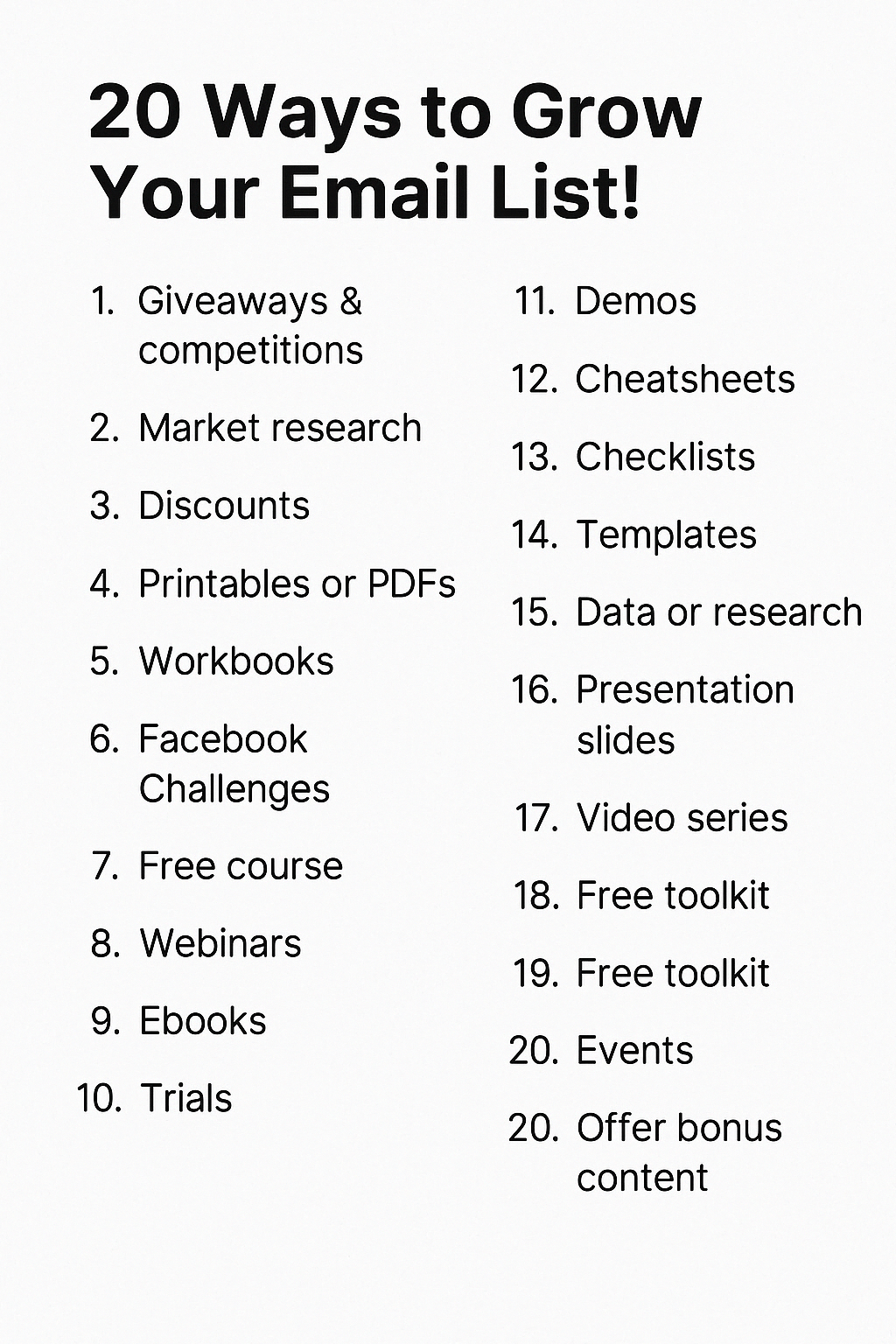
Why Businesses Rely on This Channel
Email marketing offers a rare combination of high return on investment (ROI), personalisation, and direct reach. According to the Data & Marketing Association (DMA), the average ROI for email is $42 for every $1 spent.
Some reasons why businesses invest in email campaigns include:
- Reach: Almost everyone has an inbox, and messages land right in front of users.
- Cost-effectiveness: Cheaper than many paid advertising channels.
- Targeted messaging: Segmented lists and dynamic content mean messages can be highly tailored.
- Automation: Scheduled autoresponders and triggered sends save manual effort, making scaling easier.
- Performance tracking: Open rates, click rates, and other metrics offer clear feedback.
Here’s how email stacks up against other common channels:
| Channel | Cost | Audience Reach | Targeting | Tracking | Typical ROI |
|---|---|---|---|---|---|
| Email marketing | Low | Very high | High | High | 4200% ($42) |
| Paid search ads | Medium-high | High | High | High | 200% |
| Social media ads | Medium | High | Medium | Medium | 250% |
| Direct mail | High | Medium | Low | Low | 29% |
Common Types of Email Marketing
Emails can serve a variety of purposes and can be grouped into several categories:
Promotional Emails
Usually focused on offers, discounts, or new product launches, these are designed to drive quick sales or sign-ups. Timing is often critical, with messages arriving to coincide with key events or launches.
Informational Emails
Newsletters fall into this category. They offer updates on company news, blog posts, or developments that maintain engagement without being overtly sales-driven.
Transactional Emails
These are event-driven and automated in response to user actions: order receipts, shipping notifications, account confirmations, and similar.
Automated Drip Campaigns
A series of emails triggered by actions or at set intervals (e.g. welcome sequences, onboarding workflows). These nurture leads or guide new users over a period of time.
Re-engagement Campaigns
Aimed at users who have been inactive for some time, encouraging them to open, click, or buy again.
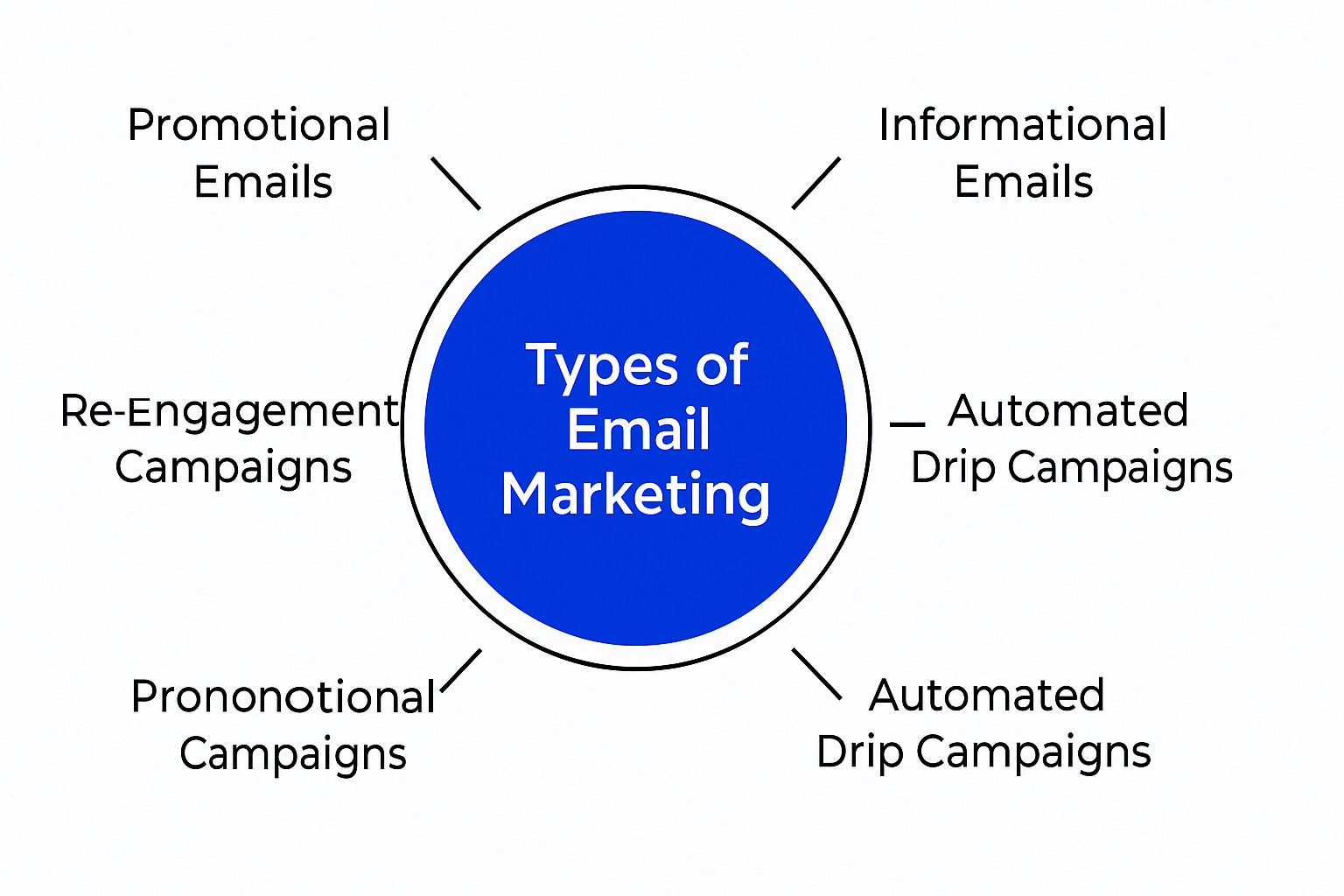
Personalisation and Segmentation
General blast emails to an entire list rarely perform as well as tailored content. Most modern platforms offer segmentation, enabling businesses to divide their list by demographics, location, behaviour, or purchase history.
Personalised emails (using the recipient’s name, past purchases, etc) have been shown to generate six times higher transaction rates. Some advanced segmentation ideas include:
- Sending special offers to the highest-spending customers
- Birthday/anniversary messages
- Location-specific updates or deals
- Cart abandonment recalls
- Course or event reminders tailored by prior activity
Designing Effective Email Campaigns
An impactful email marketing campaign blends copy, visuals, and clear calls-to-action. Templates and drag-and-drop editors in platforms like Mailchimp, Hubspot, and Campaign Monitor make it easier than ever.
Consider these important elements:
- Subject line: Short, intriguing, and relevant; 47% of recipients decide whether to open an email based on this alone.
- Preview text: The line shown alongside the subject can double open rates when used properly.
- Responsive design: Over 60% of emails are opened on mobile devices, so mobile-friendly formatting is critical.
- Call to action: Clear, compelling, and focused on a single action.
Testing, or A/B testing, allows marketers to pit different subject lines or content versions against each other to determine which works best.
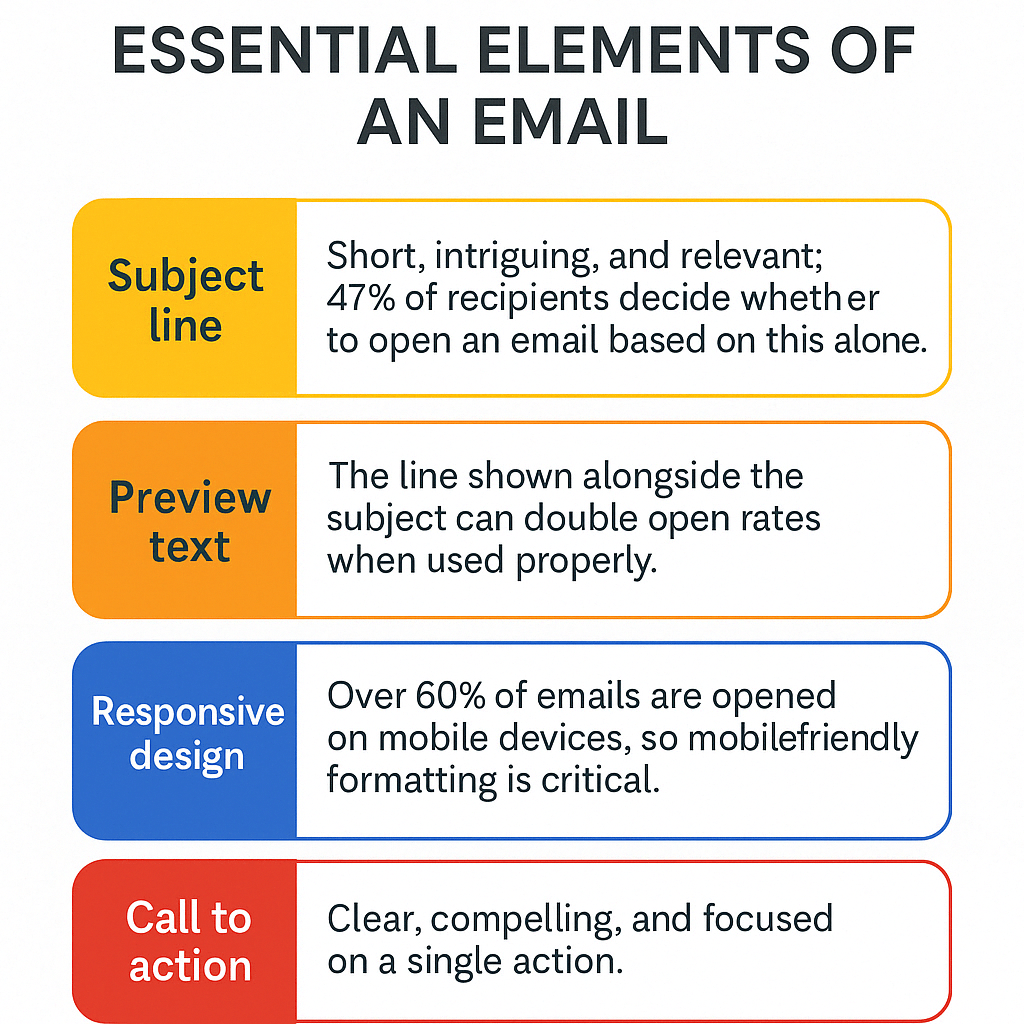
Measuring Success and Metrics
Data sits at the centre of successful email strategies. Three primary metrics are usually watched:
- Open Rate: The percentage of subscribers who open your email. Average across industries hovers around 19-21%.
- Click-Through Rate (CTR): Measures how many clicked a link inside. Standard rates range from 2-5%.
- Conversion Rate: Tied to completing a desired action (purchase, signup, booking). This can vary greatly but is usually lower than CTR. to learn more about email marketing Conversion rate you can read our other arcitle (How to Calculate Email Marketing Conversion Rate)
Other metrics that matter:
- Bounce rate (how many emails fail to deliver)
- Unsubscribe rate
- List growth
Successful teams continually tweak their campaigns in response to these numbers.
here are benchmarks for email marketing activaty
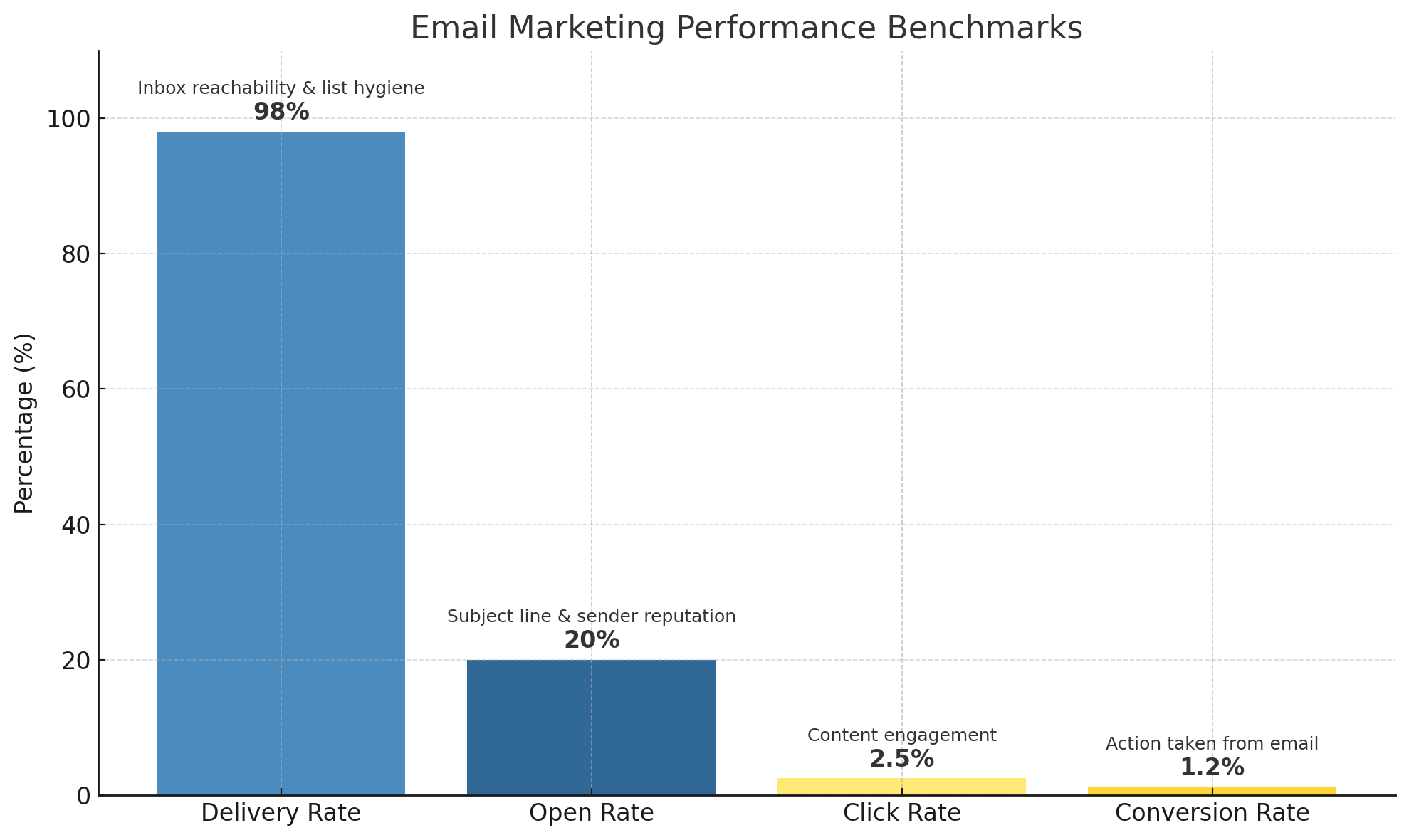
Email marketing best practices and tips
Email marketing remains a powerful tool for engaging audiences, nurturing leads, and driving conversions. To maximize its effectiveness, consider the following best practices:
🎯 1. Craft Compelling Subject Lines
Your subject line is the first impression and significantly influences open rates. Effective strategies include:
- Personalization: Incorporate the recipient’s name or location to increase relevance.
- Clarity and Brevity: Aim for subject lines under 50 characters to ensure visibility on mobile devices.
- Emotional Triggers: Use words that evoke curiosity or urgency, such as “exclusive,” “limited-time,” or “don’t miss out.”
- Avoid Spam Triggers: Steer clear of excessive punctuation, all caps, or overused phrases like “free” to prevent spam filtering.
🧱 2. Structure Your Content Strategically
Organize your email content to guide readers seamlessly:
- Inverted Pyramid Layout: Present the most critical information at the top, followed by supporting details and a clear call-to-action (CTA).
- Scannable Format: Utilize bullet points, subheadings, and concise paragraphs to enhance readability.
- Prominent CTAs: Ensure your CTA stands out visually and is placed strategically within the email.
🎨 3. Design for Clarity and Consistency
A clean and consistent design enhances user experience:
- Simplicity: Limit the use of colors and fonts to maintain focus on the content.
- Brand Consistency: Incorporate your logo, brand colors, and typography to reinforce brand identity.
- Responsive Design: Optimize your emails for various devices to ensure they render correctly across all platforms.
✅ 4. Build and Maintain a Quality Email List
Focus on cultivating an engaged subscriber base:
- Opt-In Confirmation: Use double opt-in methods to verify subscriber intent and improve list quality.
- Regular List Cleaning: Periodically remove inactive subscribers to maintain engagement rates and reduce spam complaints.
- Compliance: Adhere to regulations like GDPR and CAN-SPAM by including clear unsubscribe options and your physical mailing address.
⏰ 5. Optimize Send Timing
Timing can significantly impact engagement:
- Test Send Times: Experiment with different days and times to identify when your audience is most responsive.
- Automated Workflows: Implement automation to send emails based on user behavior, such as welcome sequences or cart abandonment reminders.
📊 6. Monitor Performance and Iterate
Continuous improvement is key to email marketing success:
- Track Key Metrics: Monitor open rates, click-through rates, and conversion rates to assess performance.
- A/B Testing: Test different subject lines, content, and designs to determine what resonates best with your audience.
- Feedback Loops: Encourage subscriber feedback to gain insights and refine your strategy accordingly.
By adhering to these best practices, you can enhance your email marketing campaigns, foster stronger relationships with your audience, and achieve your marketing objectives.
Automation and Modern Platforms
Automation has transformed email marketing. Businesses can now send highly targeted messages at just the right time based on user actions, not just a calendar date.
Popular features in leading platforms include:
- Welcome emails for new signups
- Birthday or anniversary offers
- Reminders for abandoned carts
- Triggered thank-yous post-purchase
- Re-engagement prompts after periods of inactivity
Popular platforms providing these tools include:
- Mailchimp
- Campaign Monitor
- HubSpot
- ActiveCampaign
- Klaviyo
Most of these integrate with e-commerce sites, CRMs, and analytics platforms, connecting email activity with the rest of your marketing and sales data.
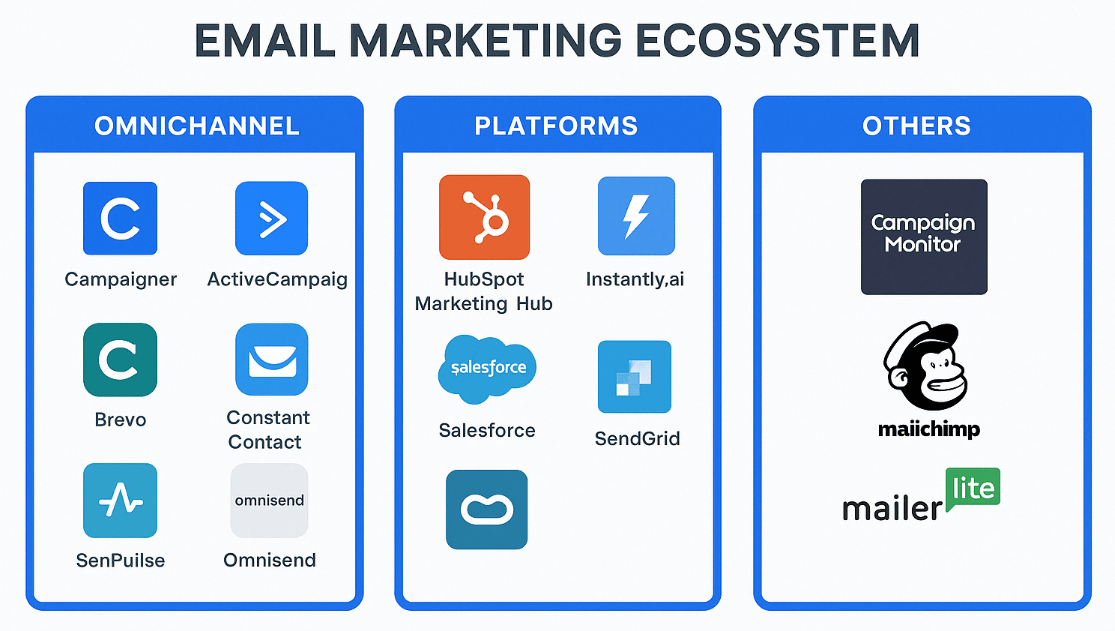
Maximizing Email Marketing Success with A/B Testing: Strategies for Data-Driven Campaign Optimization
In the dynamic landscape of email marketing, A/B testing has evolved into a critical strategy for optimizing campaign performance. By systematically experimenting with different elements of your emails, you can gain valuable insights into subscriber preferences and behaviors, leading to more effective and personalized communications.
A/B testing involves creating two or more variations of an email, each differing by a single element—such as subject lines, call-to-action (CTA) buttons, images, or content layout—and distributing them to distinct segments of your audience. By analyzing metrics like open rates, click-through rates, and conversion rates, you can determine which version resonates best with your subscribers. This data-driven approach eliminates guesswork, allowing you to make informed decisions that enhance engagement and drive results.
Even minor adjustments can yield significant improvements. For instance, altering the wording of a subject line or repositioning a CTA button can lead to higher engagement rates. A clothing retailer might test emails featuring a standalone product image versus one showcasing the product on a model to see which format encourages more clicks. Such experiments help identify the most compelling content for your audience.
Visual elements play a crucial role in capturing attention. Testing different color schemes, image placements, and text styles can reveal what appeals most to your subscribers. Don’t hesitate to challenge existing branding norms; experimenting with various designs can uncover innovative ways to connect with your audience.
Understanding your audience’s preferences is vital. While some subscribers may respond better to informative content, others might be more inclined to act on promotional offers. A/B testing allows you to segment your audience and tailor content to meet diverse expectations. For example, testing different tones—such as a friendly, conversational style versus a more formal approach—can help determine which resonates more with specific segments.
Embracing the results of your tests, even if they contradict your initial hypotheses, is key to refining your email marketing strategy. By analyzing metrics such as open rates, click-through rates, and conversions, you can gain insights into subscriber behavior and preferences. This data-driven approach enables you to make informed decisions, optimize future campaigns, and ultimately enhance your return on investment.
Incorporating A/B testing into your email marketing efforts is not just about improving individual campaigns; it’s about fostering a culture of continuous improvement. By regularly testing and refining your emails, you can stay attuned to your audience’s evolving preferences and maintain a competitive edge in the ever-changing digital landscape.

Legal and Privacy Considerations
In the evolving landscape of email marketing, adhering to global privacy regulations is paramount. Laws such as the General Data Protection Regulation (GDPR) in the European Union, the CAN-SPAM Act in the United States, and New Zealand’s Unsolicited Electronic Messages Act (UEMA) establish stringent standards to protect individuals’ data and ensure transparent marketing practices.
Under these regulations, obtaining explicit and informed consent from recipients is essential. Pre-ticked boxes or implied consent are insufficient; individuals must actively opt-in to receive marketing communications. Moreover, businesses are required to provide clear information about how personal data will be used, stored, and shared, ensuring transparency in data processing activities.
Compliance also mandates the inclusion of functional unsubscribe mechanisms in every email, allowing recipients to easily opt-out of future communications. Additionally, emails must contain the sender’s valid physical postal address, reinforcing accountability and providing recipients with a point of contact.
Data protection extends beyond consent. Organizations must implement robust security measures to safeguard personal information against unauthorized access, disclosure, or loss. Sharing personal data with third parties for marketing purposes is permissible only when explicit consent has been obtained, and individuals retain the right to withdraw this consent at any time.
Non-compliance with these laws can result in substantial penalties. For instance, violations of the GDPR can lead to fines of up to €20 million or 4% of the company’s global annual turnover, whichever is higher. Similarly, breaches of the CAN-SPAM Act may incur fines of up to $43,792 per email. In New Zealand, contraventions of the UEMA can attract penalties up to $500,000.
To navigate this complex regulatory environment, businesses should develop comprehensive privacy policies that detail data collection, usage, and protection practices. Regular audits and staff training can further ensure adherence to legal requirements, fostering trust and integrity in email marketing endeavors.
Where Email Marketing Fits in the Modern Marketing Stack
Despite claims that “email is dead”, the numbers tell a different story. Unlike social media platforms, businesses retain ownership of their lists and aren’t at the mercy of algorithm changes or platform shutdowns.
Recent surveys have shown:
- More than 60% of consumers prefer to hear from brands via email over other channels
- Email’s average open rates far outpace organic social content “reach” percentages
- Campaign Monitor reports that 78% of marketers have seen an increase in email engagement over the past year
This makes email a steady anchor in the marketing toolkit. Combining strategic segmentation, thoughtful design, and ongoing analysis, it’s possible to build campaigns that not only inform, but also drive direct, measurable actions
Practical Applications for Businesses
Smaller start-ups use email to maintain a sense of connection and inform their first customers of new features or benefits. Larger companies run sophisticated automations, segmenting millions of subscriptions across dozens of audience types.
Real-world applications include:
- E-commerce promotions and seasonal sales notifications
- Service reminders for bookings or appointments
- Event invitations and RSVP confirmations
- B2B companies sharing whitepapers and case studies
In all these cases, timely, relevant, and well-designed emails continue to drive engagement, foster loyalty, and generate ongoing revenue.
Here’s a summary of what an effective email marketing process looks like:
- Build and segment your mailing list
- Craft personalised, valuable content
- Design for mobile and test regularly
- Monitor opens, clicks, and conversions
- Tweak subject lines, CTAs, and timing in light of the analytics
Whether communicating a flash sale or providing essential account notices, email marketing delivers reliably where it counts: directly to the inbox. This consistency, flexibility, and scalability explain why it remains at the heart of digital marketing plans across industries.
